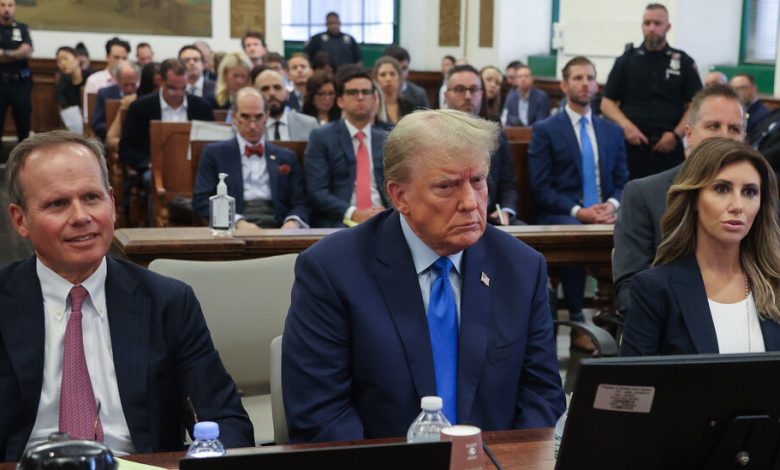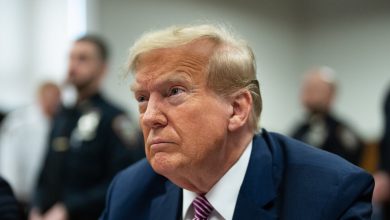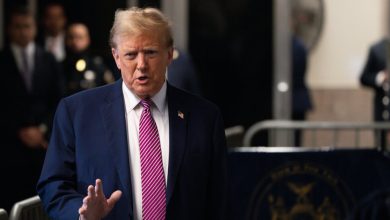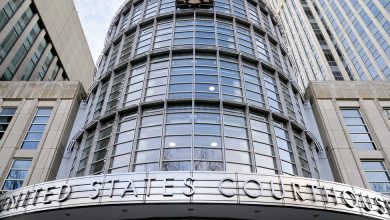Tuesday Briefing: Trump’s New York Fraud Trial Begins


Donald Trump in court yesterday.Credit…Jefferson Siegel for The New York Times
Trump’s fraud trial begins in New York
Donald Trump appeared in court yesterday in Manhattan for the first of several government trials he is scheduled to face in the coming year. Trump, who is making a run for the presidency, is accused of inflating his riches by billions of dollars and crossing the line into fraud.
The civil case is separate from Trump’s four criminal indictments and was brought by New York’s attorney general, Letitia James. “No matter how rich or powerful you are, there are not two sets of laws for people in this country,” James said in a statement.
Outside the courtroom, Trump attacked the attorney general and the judge overseeing the case, telling reporters that James was trying to damage him because he was doing so well in the polls. “There is no crime,” he said. “The crime is against me.”
The attorney general wants Trump to be fined as much as $250 million and to be barred from running a business in New York. The trial will determine what penalty the former president must pay and whether he will be in essence evicted from the world of New York real estate that made him famous.
Details: The lawsuit accuses Trump, his adult sons and their family business of inflating the value of their assets by as much as $2 billion to secure favorable loan terms from banks.
Context: Trump is already at a disadvantage. The judge overseeing the case ruled last week that Trump had committed fraud. If the ruling stands, Trump could lose control over some of his best-known New York real estate.
What’s next: The trial is expected to last several weeks and to include testimony from Trump. After the civil case wraps, Trump will face four criminal trials that touch on a range of subjects: hush-money payments to a porn star, the handling of classified documents and his efforts to remain in power after losing the 2020 election.
A Nobel for the Covid vaccine pioneers
Katalin Karikó and Drew Weissman — whose mRNA breakthrough enabled Covid vaccines to be made in less than a year, averting tens of millions of deaths — were awarded the Nobel Prize in Physiology or Medicine yesterday.
Their approach transformed vaccine technology and laid the foundation for inoculations that may one day protect against a number of deadly diseases, including cancer. But the vaccines’ rapid development — among the most impressive feats of modern medical science — was seized upon by a powerful anti-vax movement, particularly in the U.S., to undermine public trust. This is how the vaccines were made.
Long overlooked: Karikó was the 13th woman to win the Nobel for medicine. She toiled for years in what was often a very fragile scientific career. Her ideas about mRNA were definitely unorthodox, but also seem to have been prescient.
The downfall of China’s Evergrande founder
Hui Ka Yan grew up poor, in the countryside, before starting China Evergrande, the real estate behemoth that made him one of China’s wealthiest people. His life story once made him a symbol of China’s economic rise.
Now Hui is being investigated by the authorities for suspected criminal behavior, after his company filed for bankruptcy protection in August, with more than $300 billion in debt.
Evergrande said it had applied for a resumption of trading today in Hong Kong of shares of its main holding company and its property services unit.
THE LATEST NEWS
The war in Ukraine
-
Satellite imagery and aviation data suggest that Russia may be preparing to test an experimental nuclear-powered cruise missile.
-
E.U. foreign ministers traveled to Kyiv for a meeting amid deep concern about cracks in the Western support for Ukraine.
Around the World
-
Rescuers in northern Mexico recovered the bodies of at least 10 people, who died after the roof of a church collapsed during a baptism.
-
Taiwan is preparing for the arrival of Typhoon Koinu, which is expected to get stronger over the coming days and possibly make landfall on Thursday.
-
Videos and voice messages obtained by The Times revealed the mounting terror felt by asylum seekers who burned to death in Greece as they tried to outrun a wildfire.
-
Kevin McCarthy, the speaker of the U.S. House of Representatives, faces a challenge this week from Republican critics who said they would try to remove him from his leadership role.
-
Investigators looking into a deadly fire at a wedding hall in Iraq called for a half-dozen officials to be fired for their failure to enforce safety standards.
Other Big Stories
-
Sales of Tesla electric cars slipped over the last three months after the company paused production at some factories in the U.S. and China to upgrade assembly lines.
-
The U.N. Security Council approved a Kenyan plan to deploy a mission to Haiti to help quell gang violence there.
-
Sam Bankman-Fried, the founder of the failed FTX digital currency exchange, goes on trial in Manhattan today on charges of fraud and money laundering.
-
Canadian officials said a grizzly bear is believed to have attacked and killed two people in Banff National Park in Alberta.
A Morning Read
Thanks to new images from the James Webb Space Telescope, scientists have spotted nearly 150 free-floating worlds in the Orion Nebula that defy explanation, dozens of which are even orbiting each other.
Scientists have named them Jupiter Mass Binary Objects — or JuMBOs — and the reason for their appearance is a complete mystery. As one scientist put it, “they shouldn’t exist.”
ARTS AND IDEAS
Lost and found: Early synth music from India
Paul Purgas, a sound artist and curator, was looking for a lost synthesizer in India in 2017 when he stumbled across long-hidden electronic music recordings made in the country in the 1960s and ’70s.
His discovery from the archives of the National Institute of Design in Ahmedabad, India, will finally be released. The collection has been restored and will be presented in its full variety. There are manipulated field recordings, pieces linked to birds and nature, compositions inspired by Indian classical music, imagined voyages to outer space, and tracks reminiscent of bleep techno or Aphex Twin.
RECOMMENDATIONS
Bake this extremely adaptable pantry crumb cake.
Watch “No One Will Save You,” which terrifies without saying a word.
Read “Monica,” a graphic novel about a mother and daughter, steeped in counterculture.
Travel through France’s Burgundy and Provence regions on a luxury river cruise.
Listen to Becky G, PinkPantheress and the Rolling Stones on our pop critics’ latest playlist.
Play Spelling Bee, the Mini Crossword, Wordle and Sudoku. Find all our games here.
That’s it for today’s briefing. See you tomorrow. — Justin
P.S. How well do you know banned books? Take our quiz to find out.
We welcome your feedback. Send us your suggestions at [email protected].




